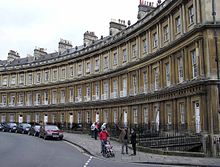Georgian period in British history
| 1714 – 1830 (1837) | |

The Georgian architecture of The Circus, Bath, built between 1754 and 1768
|
|
| Including | Regency period |
|---|---|
| Preceded by | Stuart period |
| Followed by | Victorian era |
| Monarch | |
The Georgian era of British history is a period which takes its name from, and is normally defined as spanning the reigns of the first four Hanoverian kings of Great Britain and Ireland and after of the United Kingdom of Great Britain and Ireland who were all named George: George I, George II, George III and George IV. The era covers the period from 1714 to 1830, with the sub-period of the Regency defined by the Regency of George IV as Prince of Wales during the illness of his father George III. The definition of the Georgian era is often extended to include the short reign of William IV, which ended with his death in 1837.
The term Georgian is typically used in the contexts of social history and architecture.
Georgian society and its preoccupations were well portrayed in the novels of writers such as Henry Fielding, Mary Shelley and Jane Austen, characterised by the architecture of Robert Adam, John Nash and James Wyatt and the emergence of the Gothic Revival style, which hearkened back to a supposed golden age of building design.
The flowering of the arts was most vividly shown in the emergence of the Romantic poets, principally through Samuel Taylor Coleridge, William Wordsworth, Percy Bysshe Shelley, William Blake, John Keats, Lord Byron and Robert Burns. Their work ushered in a new era of poetry, characterised by vivid and colourful language, evocative of elevating ideas and themes.
...
Wikipedia
